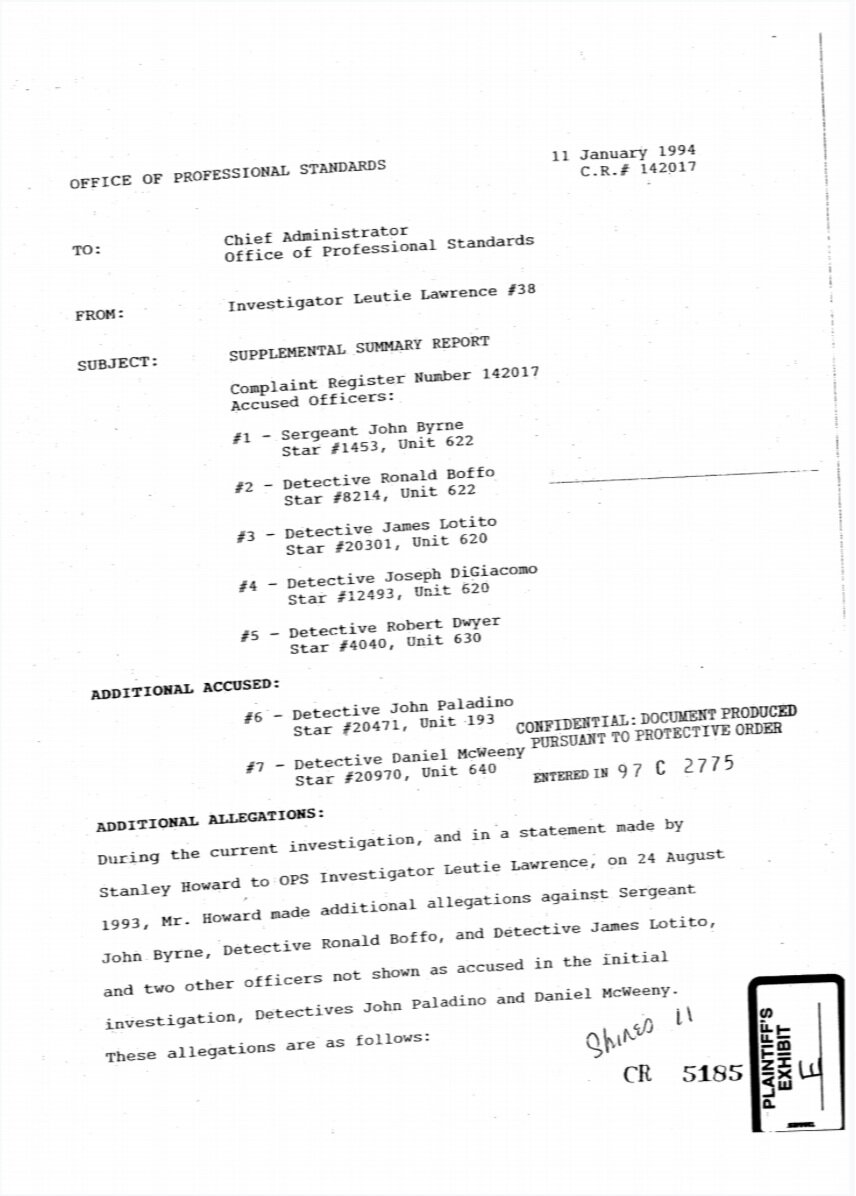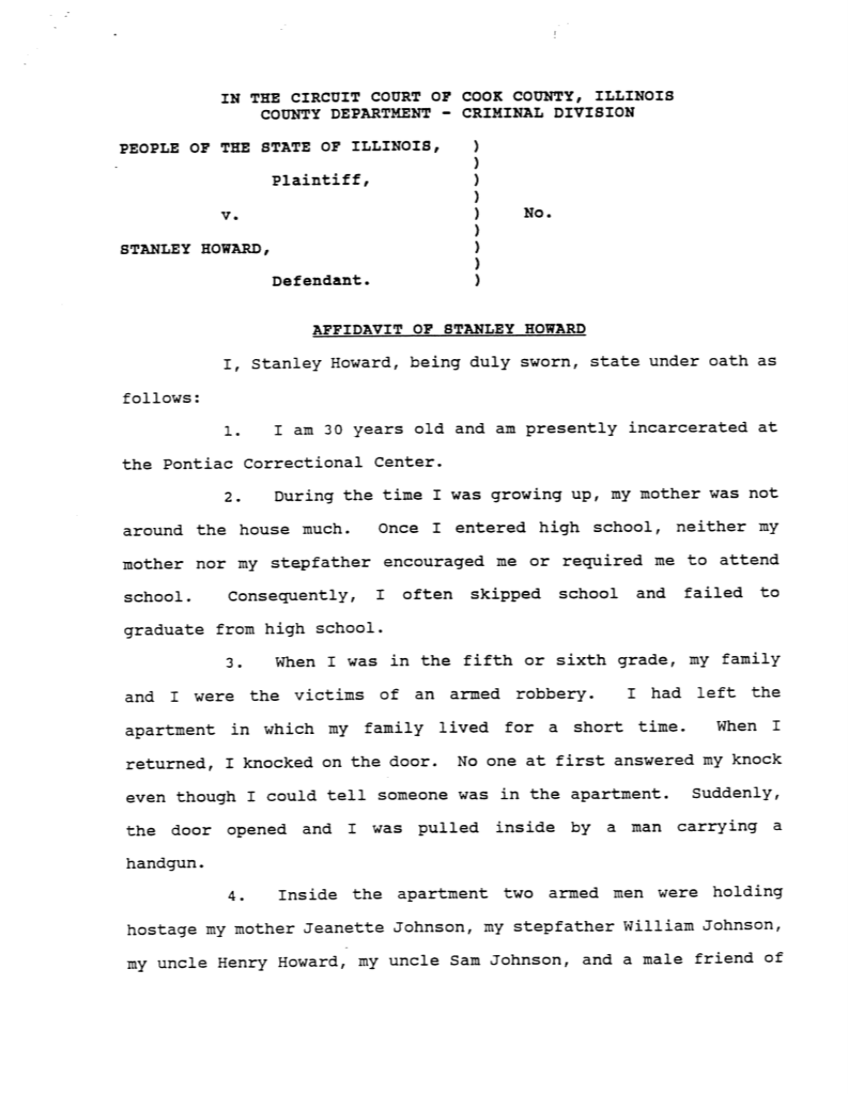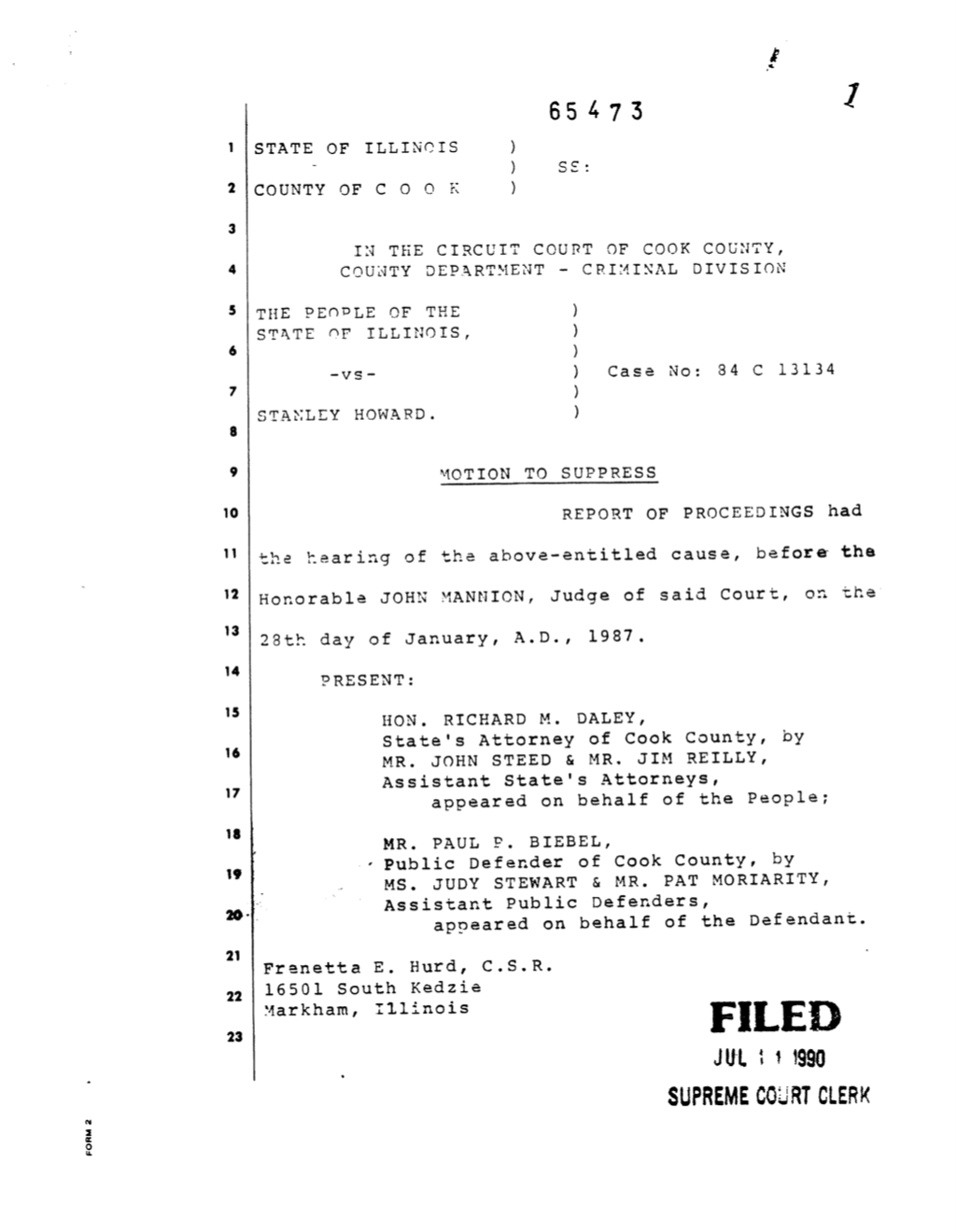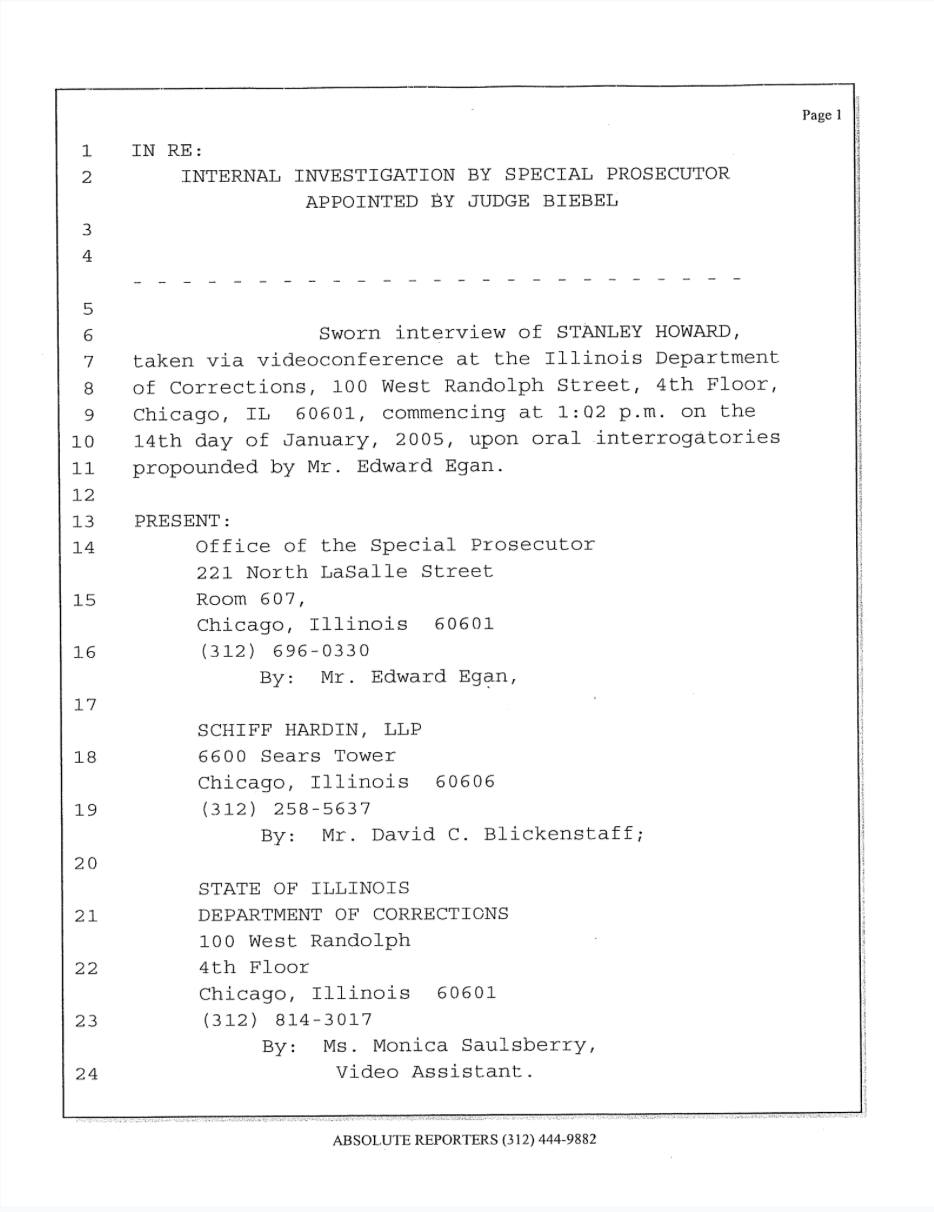Stanley Howard spent 16 years of his life on death row for a 1984 murder that evidence would later show he did not commit. Howard’s long-standing claim that he was tortured by police became central to a special prosecutor’s 2006 investigation, which determined former Police Commander Jon Burge and his “midnight crew” tortured men to extract confessions for two decades.
The South Side Murder of Oliver Ridgell
During the early morning of May 20, 1984, 41-year-old Oliver Ridgell was in his Chevrolet sedan with a woman named Tecora Mullen. According to court records, the car was parked around the corner from Mullen’s South Side home when a man approached the vehicle to ask the couple for a match. Mullen later testified that Ridgell told the man to leave. Instead, he stepped back and fired a shot into the rear driver’s side window of the car. A bullet struck Ridgell in the lower back and he died later that morning at the hospital.
Mullen, the only eyewitness to the crime, described the shooter as a Black male in his late 20s or early 30s. Her limited visibility and recollection of the perpetrator initially made it difficult for police to identify a suspect. Almost six months after the crime, the case took a turn when police arrested Stanley Howard.
Howard’s Arrest
On November 1, 1984, several plain-clothed police officers came to arrest Howard at his girlfriend’s house for a series of unrelated crimes, including the armed robbery of two off-duty Chicago police officers. After a brief chase, during which Howard injured his left hip, officers apprehended him and took him to Area 2 Police Headquarters for questioning.
Despite asking several times for an attorney, Howard was never provided with one. Area 2 detectives questioned him for several hours about the armed robbery case. It was close to midnight before officers took Howard to Roseland Hospital to have his injured thigh examined.
It wasn’t the last time Stanley Howard would be taken to Area 2.
Howard Tortured at Area 2
On November 2, Howard participated in a series of police line-ups for different cases, including the Ridgell murder. A detective suggested Howard be viewed as a suspect in the Ridgell shooting after he reportedly noted several details about the armed robbery that appeared to fit the facts of the murder case. Police brought in Mullen, the woman Ridgell had been with the night of his murder, to try to identify the man who had shot and killed Oliver Ridgell. According to the officers who conducted the line-up, Mullen made a “tentative identification” of Howard, claiming only that he “looked like the offender.”
This would notably differ from Mullen’s trial testimony three years later in which she would claim to have positively identified Howard as the perpetrator during a pretrial police line-up.
Around 2 a.m. on November 3, Area 2 detectives James Lotito and Ronald Boffo took Howard out of district lockup and brought him to an interview room. Along with Sergeant John Byrne, the three officers interrogated Howard about the Ridgell murder.
According to Howard, Lotito, Boffo, and Byrne described the details of the crime to him and then asked if he wanted to confess. Howard told them he knew nothing about the shooting—but still he said the officers punched, slapped, and kicked him to elicit a confession. When this didn’t work, Howard wrote in an affidavit later, Detective Lotito held a typewriter cover over his head, suffocating him until he lost consciousness.
Howard maintained this treatment continued until, afraid for his life, he repeated back to the officers what they had told him about how the crime occurred.
At approximately 4 a.m. that same morning, the officers took Howard to the scene of the crime to reenact, based on witness testimony, how the murder unfolded. While there, Howard said the officers were not convinced he would sign a confession. One of them uncuffed him and told him to run. Howard refused to move. He believed that if he ran, they would shoot him.
Howard Falsely Confesses to Murder
Later that day, Howard met with Assistant State’s Attorney Denise O’Malley and confessed to the murder of Oliver Ridgell, describing the crime as it was told to him by Area 2 detectives.
Howard called his stepfather to tell him about the torture he endured. His stepfather then filed a complaint with both the Federal Bureau of Investigation and the Chicago Police Office of Professional Standards (OPS), who investigated the circumstances surrounding Howard’s interrogation.
On November 4, before he was processed into Cook County Jail, Howard underwent a physical exam at Cermak Health Services. Medical records include a diagram, which the examiner used to indicate bruises and cuts he observed on Howard’s torso and wrist as well as abrasions to his left shin. Records from the exam also show that Howard complained of rib pain and that his injuries were a result of being beaten by police. When compared with medical records from Roseland Hospital, this report reveals Howard sustained new injuries in police custody that support his accusations of abuse.
Howard said the injury he sustained to his left shin, allegedly caused by repeated kicks from Sgt. Byrne, was also photographed by a public defender in a Markham courtroom. The photograph would later be introduced as evidence during Howard’s motion to suppress hearing in an attempt to prevent his confession from being heard at trial.
The officers involved in Howard’s interrogation denied all claims of mistreatment. Despite medical records and testimony from two witnesses that corroborated Howard’s account, an OPS investigation sided in favor of the police and the case was closed.
Howard went to trial for the murder of Oliver Rigdell in 1987. By then, he had already been convicted in two separate criminal cases and sentenced to 78 years by Judge John J. Mannion, the same judge presiding over the murder trial. Though Howard’s defense team pushed for a more impartial judge to oversee the Ridgell case, the murder trial proceeded with Judge Mannion in charge.
Howard’s appointed public defender, Patrick Moriarty, filed a motion to suppress Howard’s coerced confession. Judge Mannion, however, denied the motion and allowed the confession to be heard by the jury. During the trial, Mullen, the woman who had been sitting in the car with Oliver Ridgell, positively identified Howard as Rigdell’s killer.
The jury never heard about the adulterous affair between Mullen and Ridgell or from the two neighbors, who claimed they heard the shooter speak to the couple as if he knew them before pulling the trigger. Howard’s attorneys would later argue that had this evidence been presented at trial, it would have introduced an alternative motive for the crime and weakened the State’s case, which implicated Howard in an attempted robbery gone wrong.
The confession and Mullen’s identification were enough to convince the jury of Howard’s guilt.
On April 15, 1987, Howard was sentenced to death for Ridgell’s murder. After the trial, Howard learned both Judge Mannion and Patrick Moriarty were former Area 2 police officers.
The Illinois Supreme Court affirmed Howard’s murder conviction and death sentence on December 19, 1991. His appeal to the U.S. Supreme Court was denied the following year.
The Death Row 10
Allegations of police brutality followed Area 2 Commander Jon Burge and men under his command for years. Yet, it took until 1993 for the Chicago Police Board to finally fire Burge over charges that he tortured Andrew Wilson, a prisoner on death row who had been accused of killing two police officers.
After Burge was fired, OPS reopened investigations into several cases, including Howard’s. Based on new evidence and interviews, an OPS investigator produced a report in 1994 that supported Howard’s claim that he had been tortured while in police custody and that the officers involved had lied about what happened.
The new evidence did little to benefit Howard, however, as OPS held on to the report for several years without taking any action. Howard remained on death row for 15 years. There, he connected with other death row prisoners, who had also been tortured by Burge and his men into giving false confessions. With support from the Campaign to End the Death Penalty, the group organized and raised awareness around the issue of police torture in Chicago. They became known as the Death Row 10.
Howard Pardoned by Gov. Ryan
In 2002, Cook County assigned a special prosecutor to investigate the many allegations of torture against Burge and his men. A four-year investigation concluded that Burge and men under his command tortured confessions out of suspects for close to 20 years, but that they couldn’t be prosecuted for their crimes because too much time had passed. Burge was later convicted of lying about the torture in a civil lawsuit and sentenced to 4½ years in prison.
In 2003, Illinois Gov. George Ryan pardoned Howard and three other death row prisoners connected to Burge on the basis of innocence. The city of Chicago eventually settled a consolidated wrongful conviction lawsuit with the men in 2007 for nearly $20 million.
Howard Plans for the Future
Howard has now spent nearly 35 years of his life behind bars. As of October 2019, he remained incarcerated at Dixon Correctional Center for crimes unrelated to the Ridgell murder.
In April of 2018, the Invisible Institute interviewed Howard, who said he spends much of his time in prison writing and teaching other prisoners to understand criminal law. Recently, Howard co-authored a book with several Burge survivors entitled, “Tortured by Blue.”
“Now, who am I really mad at right now?” Howard asked in his 2018 interview. “It’s not the cops for doing what they did because crooked cops is going to be crooked cops...there were supposed to be safeguards within the criminal justice system that is supposed to be able to weed out these different cases,” Howard said.
Had these safeguards been in place, Howard and countless other men may not have been convicted and imprisoned, he contends. Howard believed a lot of people knew about the torture ring at Area 2 yet pushed ahead with cases anyway. “It was the whispers that was going on in the state’s attorney’s office. It was the whispers that was going on in the public defender’s office. Everybody should have said something but nobody did anything.”
When asked about what he wanted for his life after his expected parole in 2023, Howard talked about his hope to develop a non-profit organization that engages both prisoners and the community and pushes for criminal justice reform. “I want to be able to influence legislation, to change laws,” he said.
— Written by Dana Brozost-Kelleher
Documents
Media
A tortured path to death row. November 17, 1999. Chicago Tribune reporters Steve Mills and Ken Armstrong detail Stanley Howard’s case.
Interview
April 24, 2018. Journalist Amanda Rivkin interviews Howard at Dixon Correctional Center.







